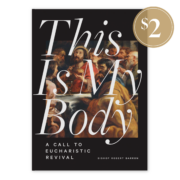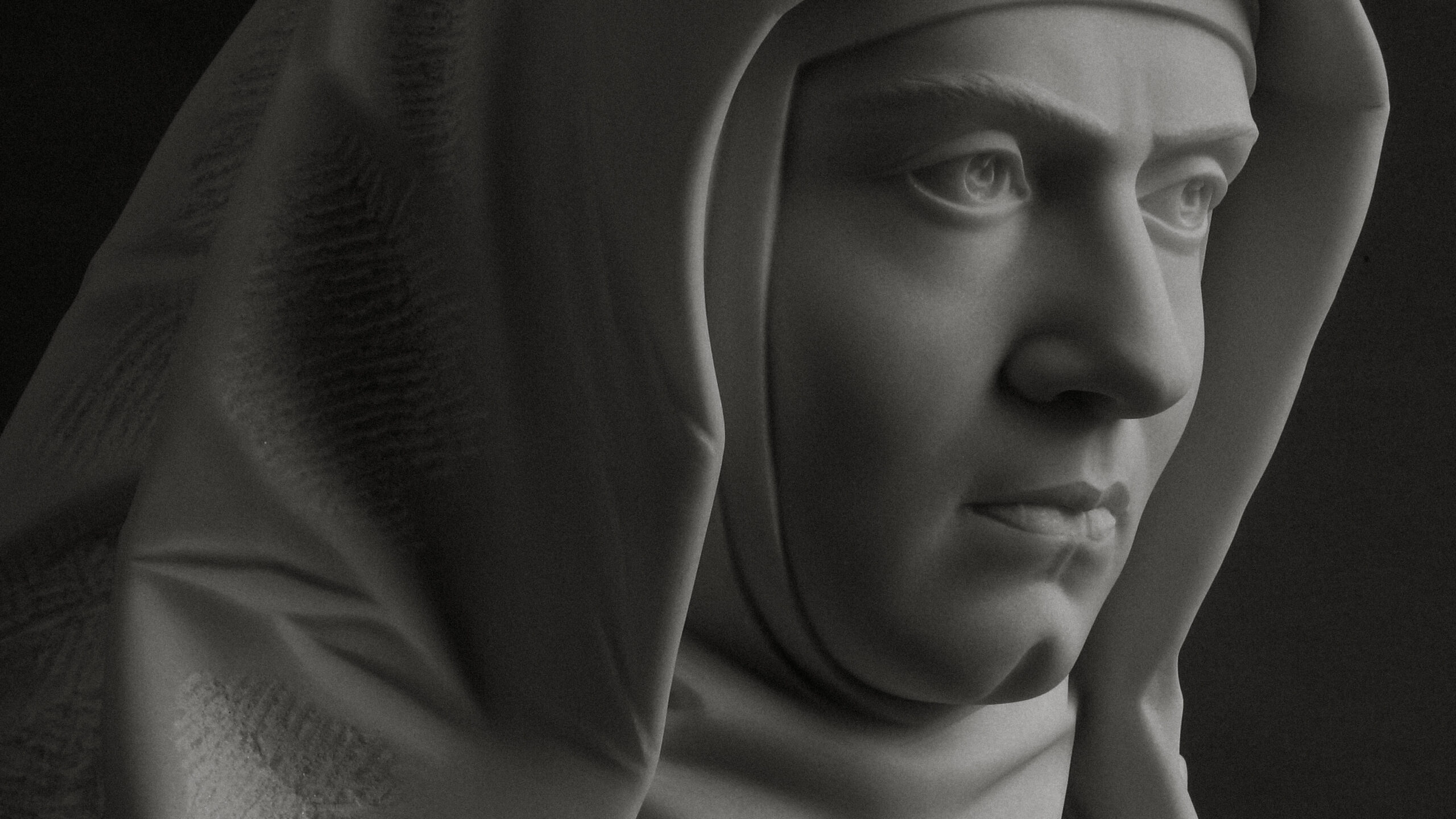In the summer of 1921, a young Jewish philosopher came upon a book that would change her life forever. While staying at a friend’s farm in Bergzabern, Germany, her fingers glided over the autobiography of the great Carmelite nun and mystic St. Teresa of Avila. She began to feverishly read the account of the great mystic and could not stop herself from continuing until she read the entire book. As her eyes and heart grasped the words on the pages, she came to a halting conclusion: “This is the truth!”
The name of that young Jewish girl was Edith Stein. And when a fellow blogger saw my struggle in marrying my Jewish roots to my newfound Christian faith, she introduced me to the Discalced Carmelite nun who later became a saint. In my frustration and search for the truth, I breathed a sigh of heavenly relief that there may be someone out there just like me, someone who shared my Jewish heritage, the love and respect for my Jewish family, and the feelings that came along with being called into Christ’s arms as a Jewish person. It seemed unreal to me at the time that someone like that even existed. But in the very beginnings of the first books I ever read about her, it was divinely confirmed that God had his hand between Edith and me. Not only did we share the same birthday, October 12, but our grandmothers also shared the same unusual name, Adelaide (Adelheid). As the tears welled in my eyes seeing the name of my beloved grandmother who had passed away eight years earlier, the connection was more than just a coincidence, it was my destiny.
. . . I wept between the pages as the story was so familiar to me, knowing that shortly thereafter, she would find Jesus.
The Jewish Catholic Saint
Edith Stein was born in Breslau, Germany, on October 12, 1891. She was the youngest of eleven children, born into a large Jewish family. From the very beginning, her story sings of greatness, as she was born on the holiest of Jewish holy days, Yom Kippur, the Day of Atonement. Her birth and entrance into this world was as poetic as it was prophetic, as many years later she would enter into the order of the Discalced Carmelites, her heart’s dream and desire after accepting Christ and the call on her life.
Like Edith, I was an extremely sensitive and empathetic child who lived close to God and felt haunted by the world’s many troubles. I understood her empathy and her interior journey into pain and suffering. It was my grandmother’s passing in 2007 that had taken me away from the God I loved. I couldn’t and wouldn’t turn to a God who had taken away the most important person in my life. And that same year I made a conscious decision to leave God behind.
I never dreamed it possible that another believer in Christ, let alone a saint, could possibly have the same thoughts I had. But it was there in the middle of those pages. Although her mother had been a pious and devout Jew, Edith, the intelligent, empathetic, and loving little girl, grew into a self-declared atheist. Edith had lost her father before the age of two, and although Edith’s mother Frau Stein was committed to her children, it became increasingly difficult for her to keep her children grounded in their Jewish faith.

Turn of Events
In 1911, a young Edith Stein found herself studying psychology at the University of Breslau in Germany where she continued to struggle with her belief in God. It was there that she began a deeper divine searching, later making the decision to follow the work of Edmund Husserl and his study of phenomenology, a branch of philosophy that was concentrated on the structures of experience and consciousness. Although Edith didn’t know it at the time, this was the beginning of her journey to Christ, along with many other of Husserl’s students who also became Christians.
It was not long after that time when Edith found herself in the midst of World War I. She instinctively knew that her desire was to serve as a nurse and help those that were wounded and in need of medical attention. So entrenched in the cause, she placed herself directly in harm’s way, working with soldiers who had a variety of contagious diseases. This empathetic young college student couldn’t bear to stand by in her world of privileged academia while her brethren were suffering. She felt compelled to be a part of their world.
This was Edith’s first real experience with death. It was during that time that she started understanding and drawing closer to the suffering of others. She internalized so much of it, and not long after that, experienced a profound loss in her own life. In 1917, one of her closest friends and mentor, Adolf Reinach, perished while serving on the front lines.
Roots of Transformation
It was in the midst of the sorrow and pain of losing one of her closest friends that Edith found her way back to God. Adolf’s widow, Anna, was a devout Christian who inspired Edith with her faith, peace, and trust in the power of the Cross. It was the first of many significant events that would lead Edith into the arms of Christ.
It was there that I found myself deeply entrenched in her story, watching God using her pain to draw her to himself. It was evident that the Creator had surrounded Edith with others whose lives were shining witnesses of the Savior’s love. And as I found myself drawn into her pain, I remembered my own journey to the Savior and the pain he had so gracefully used in my own life to draw my spirit in. The beauty of the Cross became apparent and overwhelming to me.
And so, I wept between the pages as the story was so familiar to me, knowing that shortly thereafter she would find Jesus. I marveled at God and his infinite wisdom. I felt so lucky to have found Edith and to know not just the beginning of her story but the end as well. It was the first time in my life I had felt such a strong connection to heaven. I knew without any doubt in my mind that she was there with my beloved grandmother, and she could carry my prayers to God.
The Need to Pray
I knew after reading Edith’s story that this was the truth. And after spending several years as a Jewish believer in Christ, in April of 2015, I heard God call me home to the Catholic Church. I remembered instantly an experience Edith had during one particular visit to a cathedral in Frankfurt, and I reflected on that moment as I left our local chapel after spending time in front of the Blessed Sacrament.
We went into the cathedral for a few moments, and as we stood there in respectful silence, a woman came in with her shopping basket and knelt down in one of the pews to say a short prayer. That was something completely new to me. In the synagogue, as in the Protestant churches I had visited, people only went in at the time of the service. But here was someone coming into the empty church in the middle of a day’s work as if to talk with a friend. I have never been able to forget that.
I had been moved by that same spirit. The close tie I had with praying in a conservative synagogue and my longing to find a place of reverence in my new found faith. I, too, watched the people who surrounded me kneeling before the monstrance, and I felt the presence of the Lord before I even knew what Adoration of the Blessed Sacrament was. And like Edith, the experience of the open door of the chapel brought me closer in my quest for the truth and my ultimate arrival to my Catholic faith.

The Legacy of Love
Edith Stein had come to find out the same thing I did—that the God we had always known was a God of love. God used Edith’s intelligence and search for the truth to direct her back to her very own heart, the same heart that had left him so many years earlier. And although her journey became difficult at times as a Catholic, she never strayed from her Jewish roots and her love and respect for her family and her Jewish people.
It was her love for God that ultimately led to her vocation as a Discalced Carmelite nun. During one of the most tumultuous times in world history, Edith served God behind the convent walls. But on August 2, 1942, during the height of Hitler’s reign, she was arrested by the Gestapo.
Edith’s love for her Jewish people never waned. This was apparent in these chilling words she wrote in her last will and testament:
Even now I accept the death that God has prepared for me in complete submission and with joy as being His most holy will for me. I ask the Lord to accept my life and my death . . . so that the Lord will be accepted by His people and that His Kingdom may come in glory, for the salvation of Germany and the peace of the world. I beg the Lord to take my life and my death . . . for all concerns of the sacred hearts of Jesus and Mary and the holy Church, especially for the preservation of our holy Order, in particular the Carmelite monasteries of Cologne and Echt, as atonement for the unbelief of the Jewish People, and that the Lord will be received by His own people and His kingdom shall come in glory, for the salvation of Germany and the peace of the world, at last for my loved ones, living or dead, and for all God gave to me: that none of them shall go astray.
On August 7, 1942, Edith, along with her sister Rosa and many others were transported to Auschwitz where they perished in the gas chambers at the hands of the Nazis. But in reading the final chapters of Edith’s life, it was there that I knew that she had come to find eternal life with Christ.
Edith Stein was beatified in Cologne on May 1, 1987, by Pope John Paul II and honored as she was—“a daughter of Israel.” It was her love for Christ as a Catholic that compelled me to find the truth, but it was her commitment to the Jewish people, our people, that helped me find that out.
